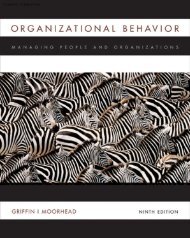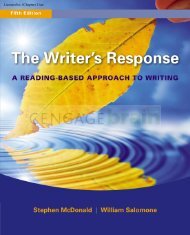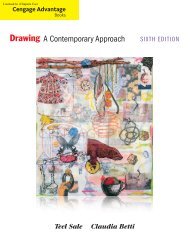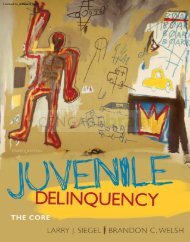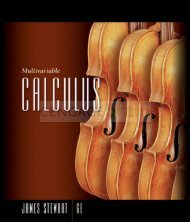Understanding Statistics in the Behavioral Sciences ... - NelsonBrain
Understanding Statistics in the Behavioral Sciences ... - NelsonBrain
Understanding Statistics in the Behavioral Sciences ... - NelsonBrain
You also want an ePaper? Increase the reach of your titles
YUMPU automatically turns print PDFs into web optimized ePapers that Google loves.
Licensed to:<br />
Answers to End-of-Chapter<br />
Questions and Problems<br />
and SPSS Problems<br />
■ CHAPTER 1<br />
6. b. (1) function<strong>in</strong>g of <strong>the</strong> hypothalamus; (2) daily<br />
food <strong>in</strong>take; (3) <strong>the</strong> 30 rats selected for <strong>the</strong> experiment;<br />
(4) all rats liv<strong>in</strong>g <strong>in</strong> <strong>the</strong> university vivarium at<br />
<strong>the</strong> time of <strong>the</strong> experiment; (5) <strong>the</strong> daily food <strong>in</strong>take<br />
of each animal dur<strong>in</strong>g <strong>the</strong> 2-week period after recovery;<br />
(6) <strong>the</strong> mean daily food <strong>in</strong>take of each group<br />
c. (1) methods of treat<strong>in</strong>g depression; (2) degree or<br />
amount of depression; (3) <strong>the</strong> 60 depressed students;<br />
(4) <strong>the</strong> undergraduate body at a large university at <strong>the</strong><br />
time of <strong>the</strong> experiment; (5) depression scores of <strong>the</strong><br />
60 depressed students; (6) mean of <strong>the</strong> depression<br />
scores of each treatment d. (1) and (2) s<strong>in</strong>ce this<br />
is a study and not an experiment, <strong>the</strong>re is no <strong>in</strong>dependent<br />
variable and no dependent variable. The two<br />
variables studied are <strong>the</strong> two levels of education and<br />
<strong>the</strong> annual salaries for each educational level; (3) <strong>the</strong><br />
200 <strong>in</strong>dividuals whose annual salaries were determ<strong>in</strong>ed;<br />
(4) all <strong>in</strong>dividuals liv<strong>in</strong>g <strong>in</strong> <strong>the</strong> city at <strong>the</strong><br />
time of <strong>the</strong> experiment, hav<strong>in</strong>g ei<strong>the</strong>r of <strong>the</strong> educational<br />
levels; (5) <strong>the</strong> 200 annual salaries; (6) <strong>the</strong><br />
mean annual salary for each educational level<br />
e. (1) spac<strong>in</strong>g of practice sessions; (2) number of<br />
words correctly recalled; (3) <strong>the</strong> 30 seventh graders<br />
who participated <strong>in</strong> <strong>the</strong> experiment; (4) all seventh<br />
graders enrolled at <strong>the</strong> local junior high school at <strong>the</strong><br />
time of <strong>the</strong> experiment; (5) <strong>the</strong> retention test scores<br />
of <strong>the</strong> 30 subjects; (6) mean values for each group<br />
APPENDIX C<br />
of <strong>the</strong> number of words correctly recalled <strong>in</strong> <strong>the</strong> test<br />
period f. (1) visualization versus visualization<br />
plus appropriate self-talk; (2) foul shoot<strong>in</strong>g accuracy;<br />
(3) <strong>the</strong> ten players participat<strong>in</strong>g <strong>in</strong> <strong>the</strong> experiment;<br />
(4) all players on <strong>the</strong> college basketball team at <strong>the</strong><br />
time of <strong>the</strong> experiment; (5) foul shoot<strong>in</strong>g accuracy of<br />
<strong>the</strong> ten players, before and after 1 month of practic<strong>in</strong>g<br />
<strong>the</strong> techniques; (6) <strong>the</strong> mean of <strong>the</strong> difference scores of<br />
each group g. (1) <strong>the</strong> arrangement of typ<strong>in</strong>g keys;<br />
(2) typ<strong>in</strong>g speed; (3) <strong>the</strong> 20 secretarial tra<strong>in</strong>ees who<br />
were <strong>in</strong> <strong>the</strong> experiment; (4) all secretarial tra<strong>in</strong>ees<br />
enrolled <strong>in</strong> <strong>the</strong> bus<strong>in</strong>ess school at <strong>the</strong> time of <strong>the</strong> experiment;<br />
(5) <strong>the</strong> typ<strong>in</strong>g speed scores of each tra<strong>in</strong>ee<br />
obta<strong>in</strong>ed at <strong>the</strong> end of tra<strong>in</strong><strong>in</strong>g; (6) <strong>the</strong> mean typ<strong>in</strong>g<br />
speed of each group<br />
7. a. constant b. constant c. variable<br />
d. variable e. constant f. variable<br />
g. variable h. constant<br />
8. a. descriptive statistics b. descriptive statistics<br />
c. descriptive statistics d. <strong>in</strong>ferential statistics<br />
e. <strong>in</strong>ferential statistics f. descriptive statistics<br />
9. a. The sample scores are <strong>the</strong> 20 scores given. The<br />
population scores are <strong>the</strong> 213 scores that would<br />
have resulted if <strong>the</strong> number of dr<strong>in</strong>ks dur<strong>in</strong>g “happy<br />
hour” were measured from all of <strong>the</strong> bars. c. The<br />
sample scores are <strong>the</strong> 25 lengths measured. The<br />
Copyright 2011 Cengage Learn<strong>in</strong>g. All Rights Reserved. May not be copied, scanned, or duplicated, <strong>in</strong> whole or <strong>in</strong> part. Due to electronic rights, some third party content may be suppressed from <strong>the</strong> eBook and/or eChapter(s).<br />
Editorial review has deemed that any suppressed content does not materially affect <strong>the</strong> overall learn<strong>in</strong>g experience. Cengage Learn<strong>in</strong>g reserves <strong>the</strong> right to remove additional content at any time if subsequent rights restrictions require it.<br />
571





